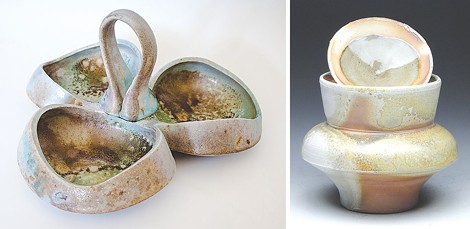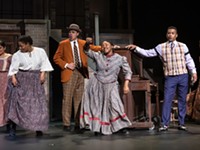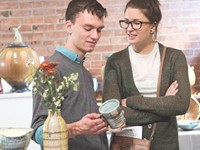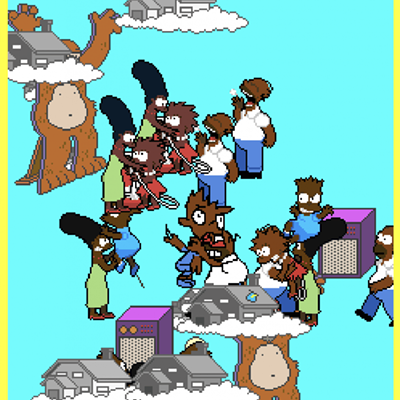Of earth and time
"History in the Making VIII: Ceramic Traditions — Contemporary Objects'"
By Rebecca Rafferty @rsrafferty[
{
"name": "500x250 Ad",
"insertPoint": "5",
"component": "15667920",
"parentWrapperClass": "",
"requiredCountToDisplay": "1"
}
]
Genesee Pottery's annual "History in the Making" exhibit provides a fascinating opportunity to see a range of great work by contemporary ceramicists from around the nation. The educational showcase also provides a specific look at the historic practices and techniques from which these artists draw influence. This year's show, juried by Fred Herbst, professor of art at Corning Community College, is rife with beautiful forms and rich colors, and smart references to historic and globe-spanning traditions in sculptural work.
Matt Wilt, of Saratoga Springs, New York, has two sturdy, beautifully glazed pottery works in the show, including the shimmering stoneware "Covered Jar Tower," for which he has drawn influence from the Asian wood-firing traditions. In particular, this stacked cylinder form is influenced not by the voluminous jars — as is his other vessel, "Covered Jar" — but by the bronze "zuns," or ritual wine vessels of Shang Dynasty China.
Brownsville, Texas-based artist Marcia Selsor's "Obvara Pot with Spirals" looks like a spiral of rough bark formed around a near perfect sphere, with a Fibonacci-esque pattern covering the swell of the form. Obvara-fired porcelain is an Eastern European, Medieval technique of sealing low-fired, functional pots by dipping the hot pot in a mixture of fermented flour.
Carol Grocki Lewis, of New York City, created a curved, elliptical vessel influenced by sculptor Richard Serra's monumental steel sculptures, with an interior that resembles Serra's weathered metal, and an exterior pattern based on her interest in fabric designs on Tapa clothes from Papa New Guinea.
In his construction of contemporary objects, John Zimmerman of Gallup, New Mexico, riffs on the fact that clay is the broken-down remnants of the earth's crust. Both his "Stratified Tire" — which reminded me of a strangely-hued Samoa cookie — and his "Stratified Beaker and Bucket," are roughly glazed in a way as to seem in the process of slow-motion disintegration. Each work lends the feeling of things being reclaimed, of complex substances breaking down to essential elements.
Poland, Ohio, potter Missy McCormick's dreamy vessel, "Cloud Reliquary," looks like the gentle dome of the sky, with a brushy glaze texture achieved through terra sigillata surface, a historic Greek and Roman technique used to achieve atmospheric effects.
Maxine Hugon's tiny, closed-form, porcelain "Orbs" are covered in carved, winding leaves and tendrils which twist off the surfaces, and are inspired by 11th century Chinese Song Dynasty carved pillows. Close by, Rochester artist Joshua Woof's wee, porcelain "Qi Vessel" like a jewel or a confection, with whorls like petals of time unfolding to reveal a tiny black hole. The work is influenced by celadon wares as well as the teachings of time and energy from the Song Dynasty.
Though Edinboro, Pennsylvania-based artist Didem Mert's elegant, wood-fired porcelain "Sauce Tray" is inspired by Indian Balti serving dishes, the artist connected three dishes together with one handle, rather than having them all separated. On the wall, Mert's "Algae II," is a sturdy ceramic hoop which supports a simple wood board, which in turn holds a tea bowl. The artist's statement reveals that the set-up is influenced by the idea of the Japanese tea house itself.
Brooklyn artist Patricia Hubbard-Ragette's tall, dark-chocolate-hued "Taurus" vessel references the Krater Volute form of Etruscan ceramics, with the titular constellation present on the belly of the piece referenced again in the curling "horns" of the vessel's dramatic handles.
Edinboro, Pennsylvania, artist Patrick Bell's simple "Wood Fired Jar" with its wabi-sabi lid handle and gloriously unpredictable wood-fired glaze was fired for 72 hours in a 19-foot Anagama kiln, recreating early traditional wood-firing techniques.
The slightly chess piece-looking "Ritual Jar," by Seth Green of Moorehead, Kentucky, is a wood-fired stoneware work influenced by a brass and silver-inlay ewer made by Syrian artist Ahmad al-Dhaki al-Mawsili in 1223. From the original work, Green retained the body form and scalloped collar, but here the work is monochrome, dark-chocolate stoneware.
Included in the show's few figurative works are two pieces by Asheville, North Carolina-based artist, Travis Winters. His "Dunce Flask" and "Mind Explosion Flask" are two playfully grotesque and richly pigmented vessels which are a modernized reference the folk tradition of face jugs.
Wheaton, Illinois, artist Marina Kuchinski explores strength versus terror in her "First World Problems," which is comprised of two forms: a representation of one of the pair of Chinese guardian lions (Shishi or "Foo Dogs") interacting with a naturalistic dog. The expressions are spot on: each beast has its ears back and fangs bared, and while the cat is a symbol of strength, the dog appears to be cowering. By replacing the second lion, the artist disrupts a traditional symbol of harmony.
Taylor Robenalt, of Sarasota, Florida, created two porcelain works of minutiae and hidden worlds which reference European figurines and flowers. In "Swan Cluster," two tiny hitchhiking frogs are found amid the crush of a petal collar, from which the swan gently lifts its elegant neck, eyes squinting. Robenalt's "Rabbit/Dog Cluster" is a double-headed beast capped with a range of flora. The artist's attention to detail is displayed delightfully in the arcing splay of rabbit ears and the kindly smirking, worldly expression of the dog.
Grand Forks, North Dakota-based artist Guillermo Guardia's "Mochica" is without a doubt the conversation work in the show. This demonic-cherub-looking ceramic child is fierce with lowered horns, red eyes, and underglazes like tattoos covering her small body. These painted patterns are drawn from the pre-Columbian, Peruvian Mochica culture. The babe bears two guns and is swathed in bullet bandoliers, perhaps referencing the tragedy of child warriors.
Speaking of...
Latest in Art
More by Rebecca Rafferty
-

Beyond folklore
Apr 4, 2024 -

Partnership perks: Public Provisions @ Flour City Bread
Feb 24, 2024 -

Raison d’Art
Feb 19, 2024 - More »









